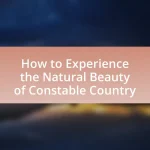Constable Country is a scenic region in Dedham Vale, Suffolk, England, renowned for its landscapes that inspired the painter John Constable. This area, designated as an Area of Outstanding Natural Beauty, features rolling hills, lush meadows, and the River Stour, which are integral to its charm and artistic heritage. The article explores the historical significance of John Constable, the key geographical features of the region, and the attractions that draw tourists. It emphasizes responsible tourism practices, including minimizing environmental impact and supporting local communities, while highlighting outdoor activities and cultural experiences available to visitors. Additionally, it addresses the potential impacts of tourism on the local ecosystem and offers tips for ensuring a positive and sustainable visit.

What is Constable Country?
Constable Country is a picturesque area in the Dedham Vale, located in Suffolk, England, known for its stunning landscapes that inspired the famous painter John Constable. The region features rolling hills, lush meadows, and the River Stour, which are characteristic of Constable’s artwork, particularly his iconic paintings such as “The Hay Wain.” This area has been designated as an Area of Outstanding Natural Beauty (AONB) since 1970, highlighting its significance in terms of natural beauty and cultural heritage.
How did Constable Country get its name?
Constable Country got its name from the famous English landscape painter John Constable, who was born in Suffolk and painted many scenes of the area in the early 19th century. His works, such as “The Hay Wain” and “Dedham Vale,” captured the beauty of the Suffolk countryside, leading to the region being associated with his artistic legacy. The name reflects both the geographical area and the cultural significance of Constable’s contributions to art, particularly in portraying the rural landscape.
What historical significance does John Constable have in this region?
John Constable holds significant historical importance in this region as he is celebrated for his landscape paintings that depict the English countryside, particularly the area around Suffolk and Essex. His works, such as “The Hay Wain” and “Dedham Vale,” capture the natural beauty and rural life of the region, influencing the perception of English landscape art. Constable’s dedication to portraying the local scenery authentically has made him a key figure in the Romantic movement, and his legacy continues to attract visitors to Constable Country, promoting cultural tourism and appreciation for the area’s natural heritage.
What are the key geographical features of Constable Country?
Constable Country is characterized by its rolling hills, lush river valleys, and picturesque landscapes. The area features the River Stour, which flows through the region, providing scenic views and a habitat for diverse wildlife. Additionally, the countryside is dotted with traditional English villages, ancient woodlands, and farmland, contributing to its rural charm. The region’s topography and natural beauty have inspired numerous artists, including John Constable, who famously depicted its landscapes in his paintings.
Why is Constable Country a popular tourist destination?
Constable Country is a popular tourist destination due to its stunning landscapes that inspired the famous painter John Constable. The area features picturesque villages, rolling hills, and the scenic River Stour, which are all integral to its charm. Additionally, the region is rich in cultural heritage, with historical sites and walking trails that attract nature lovers and art enthusiasts alike. The combination of natural beauty and artistic significance makes Constable Country a sought-after location for visitors.
What attractions draw visitors to Constable Country?
Constable Country attracts visitors primarily due to its picturesque landscapes, historical sites, and artistic heritage. The area is renowned for its stunning natural beauty, characterized by rolling hills, lush meadows, and the River Stour, which inspired the famous painter John Constable. Key attractions include Flatford Mill, where Constable painted “The Hay Wain,” and Dedham Vale, an Area of Outstanding Natural Beauty. Additionally, the local villages, such as Dedham and East Bergholt, offer charming architecture and cultural experiences that further enhance the appeal of Constable Country.
How does the natural beauty of Constable Country enhance the visitor experience?
The natural beauty of Constable Country significantly enhances the visitor experience by providing stunning landscapes that inspire and rejuvenate. The area is characterized by picturesque scenes, including rolling hills, lush meadows, and tranquil rivers, which were famously captured in the paintings of John Constable. This visual appeal not only attracts art enthusiasts but also nature lovers seeking a serene environment. Furthermore, the diverse flora and fauna contribute to a rich ecological experience, allowing visitors to engage in activities such as walking, cycling, and birdwatching, which promote physical well-being and mental relaxation. The combination of these elements creates a memorable and enriching experience for visitors, fostering a deeper appreciation for the natural environment.

What does responsible tourism mean in Constable Country?
Responsible tourism in Constable Country refers to the practice of minimizing negative impacts on the environment and local communities while maximizing the benefits of tourism. This approach encourages visitors to respect natural landscapes, support local businesses, and engage in sustainable activities that preserve the area’s cultural heritage and biodiversity. For instance, responsible tourists are encouraged to follow designated paths to protect wildlife habitats and to choose accommodations that prioritize eco-friendly practices. This commitment to sustainability is vital in maintaining the integrity of Constable Country, which is renowned for its picturesque landscapes and historical significance.
How can visitors practice responsible tourism in Constable Country?
Visitors can practice responsible tourism in Constable Country by respecting local wildlife, supporting local businesses, and minimizing their environmental impact. Respecting wildlife includes observing animals from a distance and not disturbing their habitats, which helps maintain the ecological balance. Supporting local businesses, such as shops, restaurants, and accommodations, ensures that tourism benefits the community economically. Additionally, minimizing environmental impact can be achieved by using public transport, reducing waste, and following designated paths to protect the landscape. These practices contribute to sustainable tourism and help preserve Constable Country for future generations.
What are the environmental considerations for tourists in this area?
Tourists in Constable Country should prioritize minimizing their environmental impact by adhering to local conservation guidelines. This includes staying on designated paths to protect native flora and fauna, avoiding littering, and using eco-friendly transportation options such as walking or cycling. Additionally, tourists should respect wildlife by observing from a distance and not feeding animals, as human food can disrupt their natural behaviors. According to the National Trust, responsible tourism practices help preserve the area’s natural beauty and biodiversity, ensuring that future generations can enjoy Constable Country.
How can tourists support local communities while visiting?
Tourists can support local communities while visiting by choosing to engage in responsible tourism practices that prioritize local businesses and cultural experiences. By staying in locally-owned accommodations, dining at local restaurants, and purchasing handmade crafts, tourists directly contribute to the local economy. Research indicates that when travelers spend their money in local establishments, up to 70% of that revenue remains within the community, fostering economic growth and sustainability. Additionally, participating in community-led tours or workshops allows tourists to gain authentic insights into the local culture while ensuring that the benefits of tourism are shared with residents.
What are the potential impacts of tourism on Constable Country?
Tourism in Constable Country can lead to both positive and negative impacts. On the positive side, increased tourism can boost the local economy by providing jobs and supporting local businesses, as evidenced by a report from the East Suffolk Council which highlighted that tourism contributes significantly to the region’s GDP. Conversely, negative impacts include environmental degradation, such as erosion and habitat disruption, particularly in sensitive areas like Dedham Vale, where increased foot traffic can damage natural landscapes. Additionally, the influx of visitors can strain local infrastructure and services, leading to congestion and reduced quality of life for residents.
How does increased tourism affect the local ecosystem?
Increased tourism negatively impacts the local ecosystem by leading to habitat degradation, pollution, and increased resource consumption. For instance, the influx of visitors can result in soil erosion, particularly in fragile areas, as foot traffic disrupts vegetation and destabilizes the ground. Additionally, tourism often contributes to water pollution through waste runoff and littering, which can harm aquatic life and degrade water quality. A study by the World Wildlife Fund indicates that popular tourist destinations experience a significant rise in carbon emissions due to transportation and energy use, further stressing local ecosystems. These factors collectively threaten biodiversity and disrupt the natural balance of the environment.
What measures are in place to mitigate negative impacts of tourism?
Measures to mitigate negative impacts of tourism include implementing sustainable tourism practices, enforcing regulations on visitor numbers, and promoting environmental conservation initiatives. Sustainable tourism practices focus on minimizing ecological footprints by encouraging local sourcing and reducing waste. Regulations on visitor numbers, such as entry permits or quotas, help prevent overcrowding in sensitive areas, thereby protecting local ecosystems. Additionally, environmental conservation initiatives, such as habitat restoration projects and educational programs for tourists, foster awareness and responsibility towards preserving natural resources. These measures collectively aim to balance tourism growth with environmental and cultural preservation.

What activities can tourists engage in while visiting Constable Country?
Tourists visiting Constable Country can engage in activities such as hiking, cycling, and exploring art galleries. Hiking trails like the Stour Valley Path offer scenic views and a chance to experience the natural beauty that inspired artist John Constable. Cycling routes provide an opportunity to traverse the picturesque landscapes at a leisurely pace. Additionally, art galleries and museums, including the Gainsborough’s House, showcase the region’s rich artistic heritage, allowing visitors to appreciate the works of local artists. These activities highlight the area’s cultural and natural significance, making it an enriching destination for responsible tourism.
What outdoor activities are available for visitors?
Visitors to Constable Country can engage in various outdoor activities, including hiking, cycling, birdwatching, and photography. Hiking trails such as the Stour Valley Path offer scenic views and access to historical sites, while cycling routes provide opportunities to explore the countryside. Birdwatching is popular in areas like Flatford Marsh, where diverse species can be observed. Additionally, the picturesque landscapes make Constable Country an ideal location for photography, capturing the essence of the region’s natural beauty.
How can hiking and walking trails enhance the experience in Constable Country?
Hiking and walking trails enhance the experience in Constable Country by providing immersive access to its picturesque landscapes and cultural heritage. These trails allow visitors to engage directly with the natural beauty that inspired the artist John Constable, showcasing iconic views such as Dedham Vale and Flatford Mill. Research indicates that outdoor activities like hiking can improve mental well-being and foster a deeper appreciation for the environment, which is particularly relevant in Constable Country, where the scenery is integral to its identity. Furthermore, well-maintained trails promote responsible tourism by encouraging sustainable practices, reducing the impact on local ecosystems, and supporting local economies through increased foot traffic to nearby businesses.
What are the best practices for enjoying outdoor activities responsibly?
To enjoy outdoor activities responsibly, individuals should adhere to the principles of Leave No Trace, which emphasizes minimizing environmental impact. This includes staying on marked trails to protect native vegetation, properly disposing of waste to prevent pollution, and respecting wildlife by observing from a distance. According to the Leave No Trace Center for Outdoor Ethics, following these guidelines helps preserve natural areas for future generations and maintains the integrity of ecosystems. Additionally, planning ahead by checking weather conditions and being prepared with appropriate gear enhances safety and enjoyment during outdoor activities.
What cultural experiences can tourists explore in Constable Country?
Tourists can explore various cultural experiences in Constable Country, including visiting the historic villages of Dedham and Flatford, which inspired the famous painter John Constable. These villages feature traditional architecture and local art galleries that showcase Constable’s work and the region’s artistic heritage. Additionally, tourists can participate in guided walks that highlight the area’s natural beauty and historical significance, such as the Dedham Vale Area of Outstanding Natural Beauty, which is recognized for its cultural landscape. Engaging with local artisans and attending community events further enriches the cultural experience, allowing visitors to appreciate the local crafts and traditions that have been preserved over generations.
How can visitors engage with local art and history?
Visitors can engage with local art and history by participating in guided tours of historical sites and art galleries in Constable Country. These tours often provide in-depth knowledge about the region’s cultural heritage and artistic contributions, such as the works of John Constable, a prominent landscape painter. Additionally, visitors can attend local art exhibitions and workshops that showcase the talents of contemporary artists, fostering a connection to the area’s artistic community. Engaging with local museums, which often feature artifacts and displays related to the region’s history, further enhances visitors’ understanding of Constable Country’s significance.
What events and festivals are significant in Constable Country?
Significant events and festivals in Constable Country include the Dedham Vale Arts and Crafts Festival, which celebrates local artists and craftspeople, and the Constable Country Show, showcasing agricultural traditions and local produce. These events highlight the region’s cultural heritage and community spirit, attracting visitors and promoting responsible tourism. The Dedham Vale Arts and Crafts Festival typically features exhibitions, workshops, and performances, while the Constable Country Show includes livestock displays, competitions, and food stalls, emphasizing the area’s agricultural roots.

How can tourists ensure a positive experience in Constable Country?
Tourists can ensure a positive experience in Constable Country by planning their visit during off-peak times, engaging with local guides, and respecting the natural environment. Visiting during weekdays or outside of school holidays minimizes crowding, allowing for a more enjoyable exploration of the area’s scenic landscapes. Utilizing local guides enhances the experience by providing insights into the history and culture of the region, which is rich in artistic heritage, notably linked to the painter John Constable. Additionally, adhering to the principles of responsible tourism, such as staying on marked paths and avoiding littering, helps preserve the natural beauty of Constable Country for future visitors.
What tips should visitors follow for a responsible visit?
Visitors should follow these tips for a responsible visit: respect local wildlife and habitats, adhere to designated paths, and minimize waste. Respecting wildlife ensures that animals are not disturbed, which is crucial for maintaining ecological balance. Adhering to designated paths prevents damage to sensitive areas and preserves the natural landscape. Minimizing waste, such as by using reusable containers and properly disposing of trash, contributes to environmental sustainability. These practices are essential for protecting Constable Country’s natural beauty and ensuring that it remains a viable destination for future visitors.
How can planning ahead enhance the tourism experience in Constable Country?
Planning ahead enhances the tourism experience in Constable Country by allowing visitors to optimize their itineraries and make informed choices about attractions, accommodations, and activities. By researching local sites such as Flatford Mill and Dedham Vale, tourists can prioritize their visits based on personal interests and seasonal events, ensuring they do not miss key experiences. Additionally, pre-booking accommodations and guided tours can lead to better rates and availability, as evidenced by the high demand during peak seasons. This proactive approach not only maximizes enjoyment but also supports local businesses, contributing to sustainable tourism practices in the region.
What resources are available for tourists to learn about responsible practices?
Tourists can access various resources to learn about responsible practices, including official tourism websites, local visitor centers, and educational workshops. For instance, the Constable Country tourism website provides guidelines on sustainable travel, highlighting eco-friendly accommodations and activities. Additionally, local visitor centers often offer brochures and information sessions focused on responsible tourism practices, such as wildlife conservation and cultural respect. Workshops and community events also serve as platforms for tourists to engage with local experts and learn about sustainable practices directly from the community.


